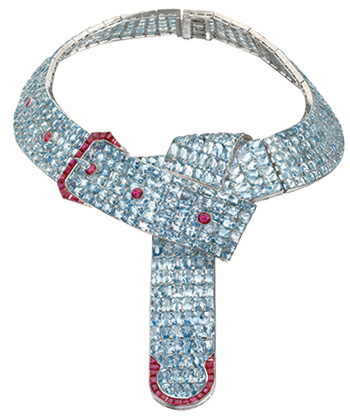|
Legacy
A Certain Panache
Paul Flato beguiled society and Hollywood elite with jewelry that was both stylish and unique.
By Phyllis Schiller

|
| Aquamarine, ruby and platinum belt buckle necklace designed by Fulco di Verdura for Paul Flato, New York, circa 1935. Photo courtesy of Siegelson. |
Running the gamut from diamond and platinum en tremblant pieces to gold hand brooches spelling out the sign language alphabet, Paul Flato’s jewelry always had a strong sense of individuality, says Peter Schaffer, co-owner of A La Vieille Russie in New York City. “There’s a strength in his pieces, a certain panache. People can recognize Flato’s jewelry by the quality of the workmanship and the quality of the stones.”
But it was never just about the stones, points out Gus Davis, partner, Camilla Dietz Bergeron, Ltd., New York City. “It’s really about the design and the whimsy. It’s the design that identifies his work.”
According to Elizabeth Irvine Bray, author of Paul Flato: Jeweler to the Stars, Flato’s designs “are striking and unusual and resonate with people both for his compelling story and the pieces themselves.”
Flato’s story begins on September 1, 1900, in the town of Shiner, Texas. Although he came to New York City to attend Columbia University in 1920, he dropped out and apprenticed himself to Fifth Avenue jeweler Edmund Frisch, Bray relates in her book. Within a few years, he had opened his own shop. The wealthy friends he made at Columbia helped him attract an elite clientele of the rich and famous. He participated in fashion shows and charity events, establishing himself as a go-to designer.
“If you think about the jewelers after the Deco period,” says Davis, “there were not many ‘names’ of singular American designers who stood out. Flato is really the first jeweler who became a name on his own.” And it wasn’t just an East Coast phenomenon.
In 1938, director George Cukor asked him to design jewelry for Katherine Hepburn to wear in the movie, “Holiday.” That same year, Flato opened a Hollywood branch on Sunset Boulevard. Hepburn, Rita Hayworth, Greta Garbo, Marlene Dietrich and Ginger Rogers were just a few of the show business “royalty” who wore his jewelry.
“For a brief period in the 1930s and 1940s,” says Lee Siegelson, president and owner of Siegelson in New York City, “Flato was the most recognizable jeweler for the Hollywood elite. He created spectacular, playful jewelry that was clever and stunning and wonderfully made.”
Flato created diamond-set naturalistic floral pieces, says Bray, “which reflected the 1930s taste for femininity and glamour,” as well as more approachable “daytime” gold pieces, which often had an element of whimsy to them. “This could be a pair of gold hand brooches or a telephone dial compact. He liked making personalized pieces, so initials, inside jokes, nicknames were often included in the piece.” As Flato developed his distinctive style, he worked closely with talented designers, including Fulco di Verdura.
“He knew how to articulate exactly how he wanted something created,” says Davis. “He knew what could be accomplished and he pushed the envelope.”
Flato’s pieces are imaginative and often unusually oversized, says Siegelson, “but in a manner that is handled with grace and elegance.” Unusual color combinations and attention to detail are hallmarks of Flato’s work, says Bray. His iconic belt buckle necklace, shown right, originally made for Mrs. Cole Porter in 1935 and now owned by Siegelson, was “entirely set with clear blue aquamarines with the detail in ruby — the pale blue and deep red combination is stunning,” Bray adds.
Flato’s illustrious clients often were slow in paying him. In an unwise move, he pawned gems left with him on consignment, using the cash to keep his business going, with the idea that he would buy the pieces back. But when an investigation revealed his actions, time ran out. He was convicted of grand larceny and sentenced to Sing Sing prison in 1943. “Flato went to prison twice and reinvented himself after both experiences,” says Bray. After his first stint, he got back into jewelry through low-cost costume jewelry compacts in the early 1950s, she says. “These are very collectible on eBay and can be obtained for a few hundred dollars. His second stint in prison — first in Mexico to avoid extradition and then finally back at Sing Sing in the 1960s — really changed him.”
Starting over once again in Mexico City, Flato created pieces in 18-karat gold inspired by the indigenous art and artifacts of the country, Bray continues. “These pieces come to the market more frequently and do not attract the astronomical prices of his earlier pieces; however, they are truly fascinating in their own right. He designed jewelry until he was in his 90s.” Flato died on July 17, 1999, in Fort Worth, Texas. He was 98 years old.
According to Davis, “in the past ten years, Flato’s jewelry has become very, very hot again.” His jewelry is very much sought after, agrees Schaffer, “prices continue to go up. His early pieces are very desirable but there’s not a lot around.”
The people who purchase a great piece of Flato don’t let it go easily, says Siegelson, “and there aren’t that many pieces because he only made fine jewelry for a relatively short period. The prices are consistently high for a great piece of Flato.”
“Flato was so innovative and interesting that the jewelry sustains the test of time,” sums up Bray. “His pieces hark back to the glamour of the 1930s, but also feel very modern and wearable today.”Article from the Rapaport Magazine - October 2015. To subscribe click here.
|
|